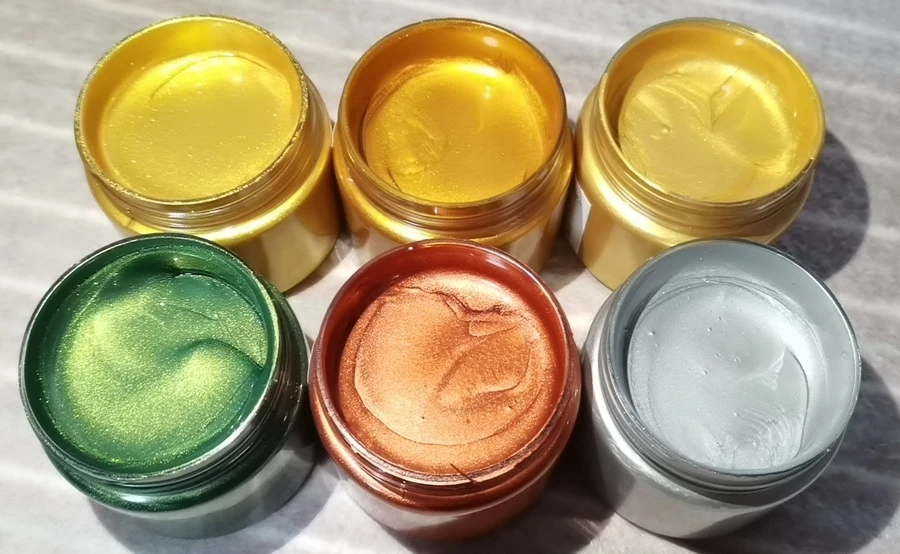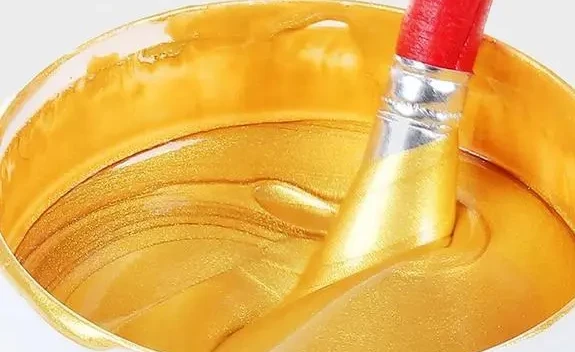What types of metallic pigment powder for paint can provide metallic or pearlescent effects?
The following metallic pigment powder for paint has a metallic and pearlescent gloss:
1. Aluminum pigments
Aluminum powder pigments are currently the most common flaky pigments in industrial applications. They include floating and non-floating types. Non-floating aluminum powder pigments account for more than 80% of the market share.
Non-floating aluminum powder pigments include pigments with larger particle sizes and crystal luster, and pigments with smaller particle sizes and silk luster. Due to the organic color film, surfaces can be well wetted for pigments. Pigments are evenly distributed in powder coatings.
Most of floating aluminum powder pigments are bright. They even have chromium-plated effects and excellent covering power on films.
2. Bronze powder pigments
Ordinary bronze powder pigments are floating flaky pigments. They are made by melting, ball milling and grading of copper, zinc and aluminum alloy, according to a certain proportion. If the content of copper changes, bronze powder pigments will have different colors.
There are green gold, red gold, bronze gold and other series. The larger the particle size of bronze powder pigment, the stronger the metallic feeling, the poorer the covering power. More pigments are needed in paint. On the contrary, the smaller the particle size, the weaker the metallic feeling, the softer the color, and the stronger the covering power.
Powder paint formula designers can choose bronze powder pigments of different particle sizes and colors according to customer requirements.
The surface of bronze powder particles can be coated with a layer of organic materials. This can reduce the density of bronze powder particles, increase the surface tension, and improve heat resistance. Bronze powder pigments may fade in different climates and chemical environments, so the film luster will decline.
3. Pearlescent pigments
Pearlescent pigments have a pearl luster. There is titanium dioxide or other materials on the surfaces of mica substrates. Coating pigments have pearlescent effects, due to multiple reflections and transmissions of light.
Metal oxide paint has different interference effects. They have pearlescent color changes and even “color transfer effects”.

At present, pearlescent pigments are in silver, intrigue and tinted colors. Due to chemical modification and coatings, pearlescent pigments can adapt to all natural and synthetic resin systems. They are also suitable for thermosetting and thermoplastic powder paints.
What are the characteristics of metallic pigment powder for paint?
1. High gloss
The greatest feature of metallic pigments is high gloss. Metallic pigments have a unique metallic texture and gloss, so they are more attractive than ordinary pigments. They are suitable for products with a better texture and higher quality.
2. Bright color
Metallic pigments can be combined with a variety of colors for bright and unique colors. For example, metallic pigments can be combined with red and yellow to achieve unique and bright red color effects.
3. Light resistance
Metallic pigments have good light resistance. They are not easy to fade after long-term exposure to the sunlight. They are often used in outdoor signs, body coatings, etc. They can improve the durability and quality of products.
4. Corrosion resistance
Metallic pigments usually have good corrosion resistance. They can effectively extend the service life of products. Metallic pigments have higher corrosion resistance than other pigments. Especially for products under harsh conditions, metallic pigments are indispensable.
In short, metallic pigments are widely applied. They are irreplaceable in cosmetics, printing or automobile manufacturing. They have high gloss, bright colors, light resistance and corrosion resistance.

How to add metallic pigment powder for paint?
The mixing of metallic pigment powder for paints needs to take into account the proportions of the different components and usually needs to be done by a professional.
The specific proportioning process is as follows:
- Select the main color paint and the blending paint as the base material, and add the light effect factor (pearlescent powder, gold powder, bright silver powder or aluminum powder) according to the degree of metallic effect required.
- Mix various pigments, varnishes, solvents, etc. according to the proportion until the desired metallic glitter effect is achieved. This step requires an experienced master to operate. The painter should have some experience and be familiar with the performance of each manufacturer’s products to maximize the quality. Attention should also be paid to the amount of pigment and its compatibility with other resin systems. For some special formulations and color modulations, special surface treatment techniques and special additives are required to improve the appearance of the coating. All of these require in-depth understanding of color science and research to achieve.
- The formulated metallic paint needs to be sprayed onto a specific substrate, and the state of the powder needs to be observed and appropriately adjusted to achieve the desired effect. This includes controlling aspects such as particle size, gloss and color performance. After the initial specimen is completed, it is verified by relevant tests to ensure the feasibility of the final result. This step may require several attempts and fine-tuning of various parameters to obtain satisfactory results.
- After confirming that all conditions are as expected, the corresponding metallic paint coatings can be mass-produced and applied on a large scale. Care should be taken to keep the environment neat and clean so that impurities are not mixed in to affect the quality of the product.
What are the uses of metallic paint?
Metallic pigments are used in metallic paint of motorcycles, electrical appliances, light industrial machinery, petrochemicals, shipbuilding, aerospace, civilian products, hardware, etc.
1. Metallic Paint for Printing
Metallic pigments are widely used in the printing industry. They can bring better visual impact, making prints more attractive and aesthetic. They are also applicable to the production of fluorescent paper and color packaging materials. They can improve the appearance and quality of packages.
2. Metallic Paint for Automobile manufacturing
Metallic pigments are also very common in automobile manufacturing. They have better visual effects on automobiles, making automobiles more artistic and popular. Due to the light resistance, wear resistance and corrosion resistance, they are also widely applied in automotive paints, body coatings, etc.
Pigment for Paint Uses
Continue Reading



